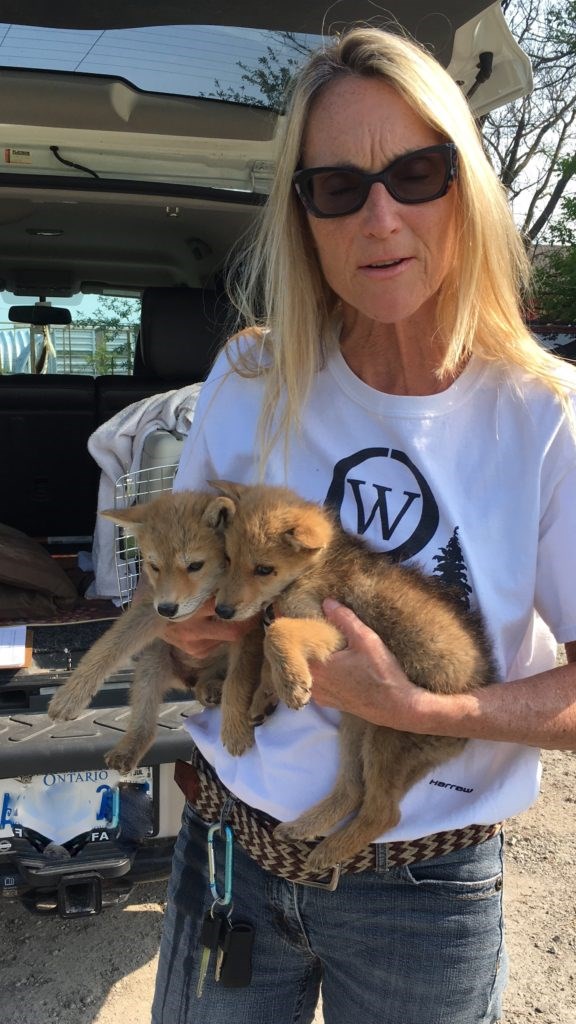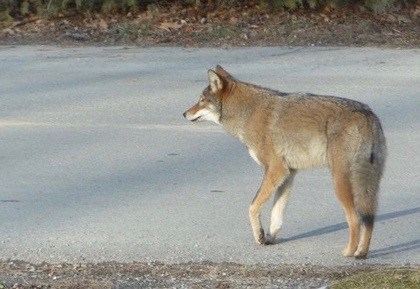
A Niagara expert in coyotes was surprised to learn about recent concern for the presence of the animals in the Old Town.
About 20 years ago, Lesley Sampson, then studying coyotes in the William Street area of Niagara-on-the-Lake, made a presentation to Town council to calm the fears of residents in the area.
Hearing there are still reports of coyotes in the same neighbourhood surprised her, but she’s grateful the sightings have not created the level of concern they did then, she says.
She spent about six years studying a family of coyotes in the area back in the 90s, even staying in a tent at night to investigate their behaviour. It’s “entirely possible" the coyotes people are now seeing now are descendants of those animals, she says, which, for her research purposes, she named the Creek Park Pack.
When she learned then that coyotes in the area were being shot, pups taken from their den, and residents lobbying the Town to undertake a relocation program, she stepped in to help quiet the maelstrom.
She recalls going to see the late Bob Howse, the Town clerk at the time, whom she looks back on today as a trailblazer. She asked if she could speak to councillors about educating the public, which she did, and with his support the controversy died down as residents became more understanding and less fearful.
The level of peaceful existence with nature has come a long way since then, but the Town could have furthered the process by keeping the education program alive, she said.
“The Town didn’t do what it should have done, which was continue to educate the public. History doesn’t need to repeat itself.”
Sampson, founder and executive director of Coyote Watch Canada, speaks to municipalities and residents across the country, dispelling myths about coyotes, educat- ing the public and encouraging an acceptance of living in harmony with wildlife.
A specialist in coyote behaviour, she believes education is key, and says it’s time for the Town to once again begin engaging the public.
“If you’d asked me in the 1990s where I hoped the work I was doing would lead to, I had my dreams. Many of them have come to fruition through the wonderful compassion and collaboration in communities. NOTL can still become a flagship model for a community that has an engaging education program, empowering the co-existance of residents and coyotes and giving residents strategies to encourage and celebrate co-existance.”
Although neighbourhoods are changing and the animals may be displaced, the biggest single factor in their increased presence is likely to be residents who are feeding them, she says.
“If you put food out, a coyote will go to it. That’s what they’re conditioned to do.”
If there have been multiple sightings, it’s time for residents to “wildlife-proof ” their properties, she says.
She encourages home owners to keep their decks sealed to discourage wildlife. She remembers having to relocate a mother and pups from under a NOTL deck — if you have an open deck, make sure there are no dens before sealing them.
Be a responsible pet owner, she adds — keep dogs on a leash and cats inside. And above all, don’t leave food out.
While it is mating time, that shouldn’t increase their presence — they tend to mate for life, unless something happens to their partner, and their tendency to monogamy means they’re not likely to cruise urban streets looking for a partner. They are more visible in winter, she says, stressing it’s common for residents who see them in their neighbourhood to begin leaving out food — they may enjoy watching them, want to show them off to their grandchildren or just take photographs. But neighbours begin to think they are seeing several coyotes, when it’s likely it’s the same one looking for the easy meal its become accustomed to finding.
If coyotes aren’t rewarded by food, they aren’t likely to return to the area, she says. It’s no different than birds returning to a bird feeder or squirrels hanging out below one, she explains, but she cautions against assuming it means coyotes are becoming less fearful of humans and more aggressive — they have simply become conditioned to look for food they’ve come to expect.
If people are feeding them, she suggests “being considerate to your neighbours, their pets and other wildlife. Don’t feed them.”
When the presence of coyotes became a concern for Niagara Falls residents, the City passed a bylaw banning feeding them, with a fine of $5,000 for anyone convicted of contravening the legislation. Other municipalities have accomplished the same goal by enforcing property standards bylaws, she says.
If the Town steps in and does its part to educate residents it could prevent coyotes from being seen as a threat.
“I’ve never met one resident who, when I explained, didn’t come to understand and accept the concept of food conditioning. Educating the public is paramount.”
The Ministry of Natural Resources website Is a good source of information, as is Coyote Watch Canada. She encourages using its website to report sightings of coyotes in urban areas, and if the reported behaviour seems outside the norm, it will be investigated.
One of Sampson’s pet peeves is the use of the term “coywolf,” as if it’s a new species that has made its way to Niagara.
Although the nickname has been coined in recent years, the animal itself is nothing new — that’s one of the myths she works hard to dispel. Its DNA dates back 100 years, when the western coyote made its way east to Ontario, and mated with the Algonquin (or eastern) wolf, producing what became the eastern coyote, she says.
“The coywolf isn’t a thing. It’s a nickname,” she says. “We have one species of coyotes in Ontario.”
The coyotes seen in Niagara, or anywhere in Ontario, are eastern coyotes, and yes, their DNA will show some Algonquin wolf, but there is nothing new about it, says Sampson.
It’s part of the canid family, which includes wolves and foxes. Sightings of particularly large, healthy-looking coyotes further promote the idea of a new hybrid, but the average coyote seen in Ontario is about 35 to 38 pounds, says Sampson. While she’s received reports of much larger examples and gone to investigate, they turn out to be exaggerated. She has weighed one female at 55 pounds, but that is an anomaly, she says.
Some coyote specialists feel the eastern coyote’s name should be officially changed to coywolf, believing it would offer the animal some level of protection.
“I’m not opposed to that,” she says, but she does get frustrated and impatient about the belief that some wolf DNA in the animal makes it more fearful, often described with words such as “bold and brazen.”
“The fear level then increases, but it’s no different than the coyotes that have been seen in Ontario for the last 100 years.”
